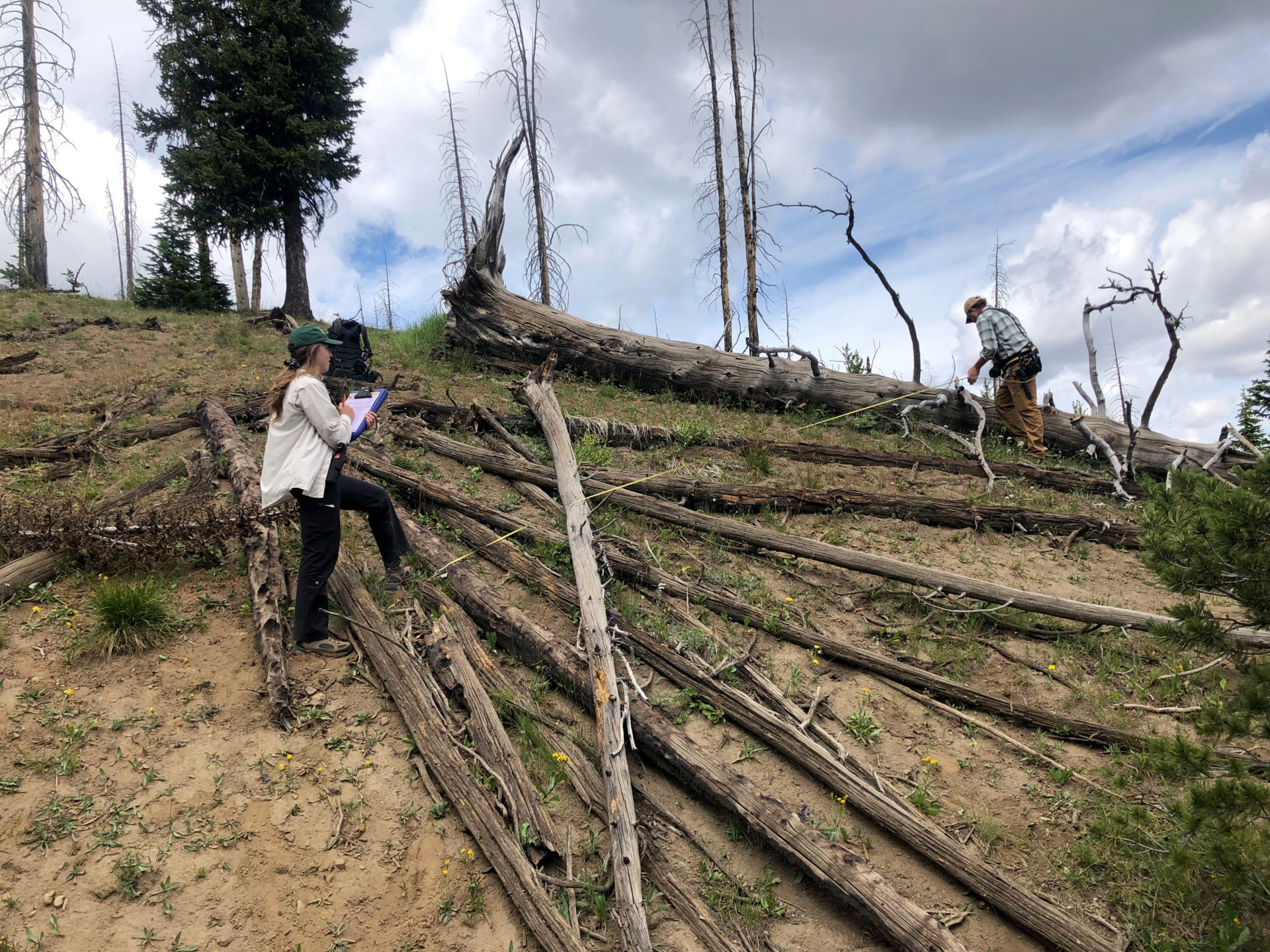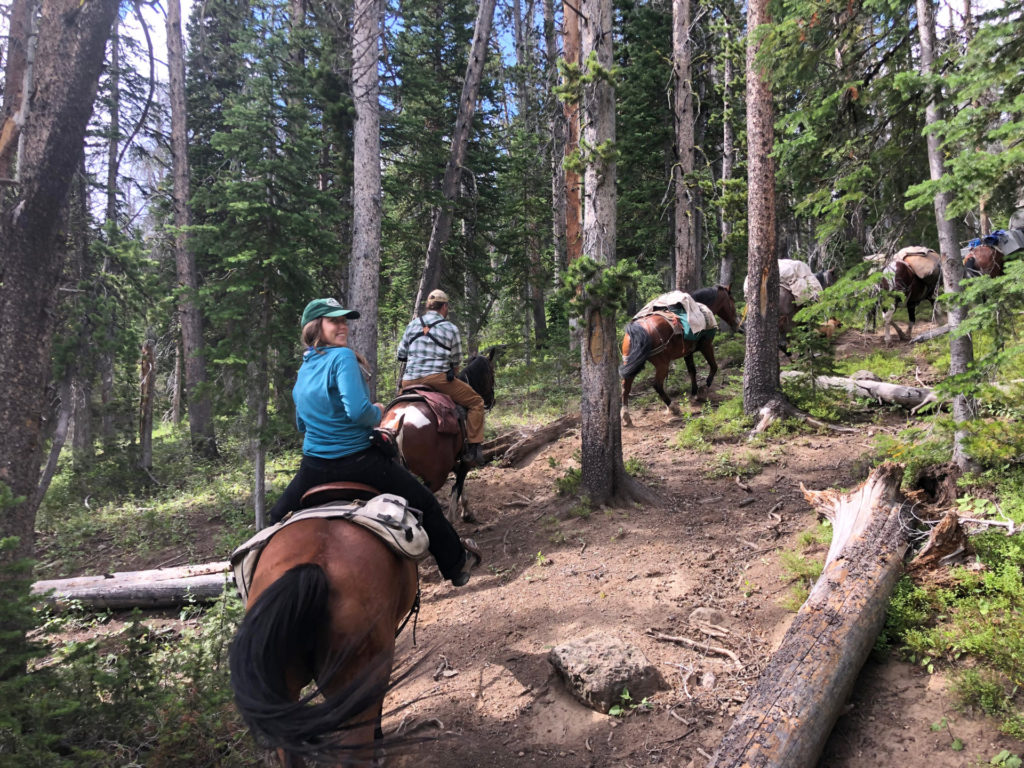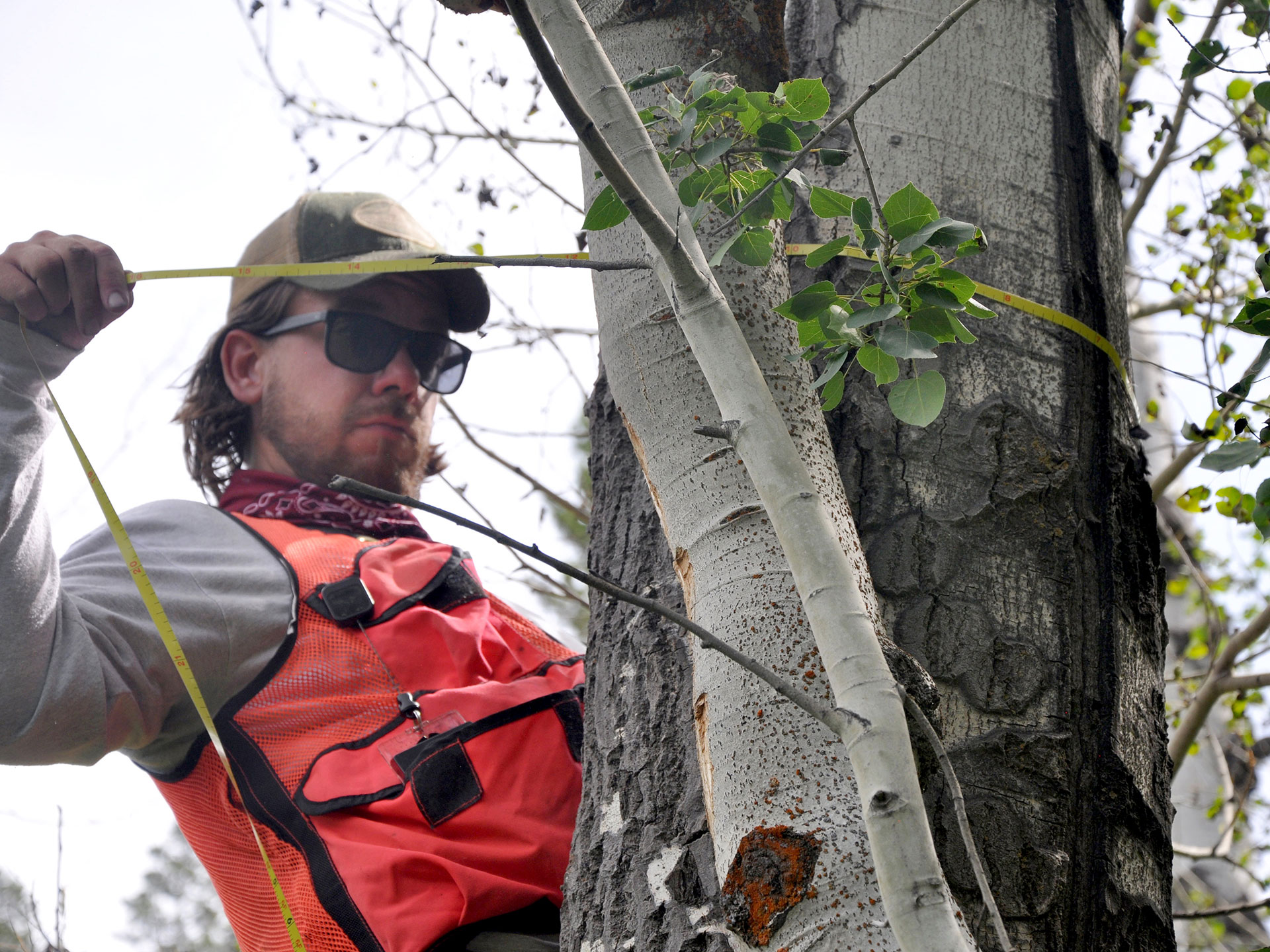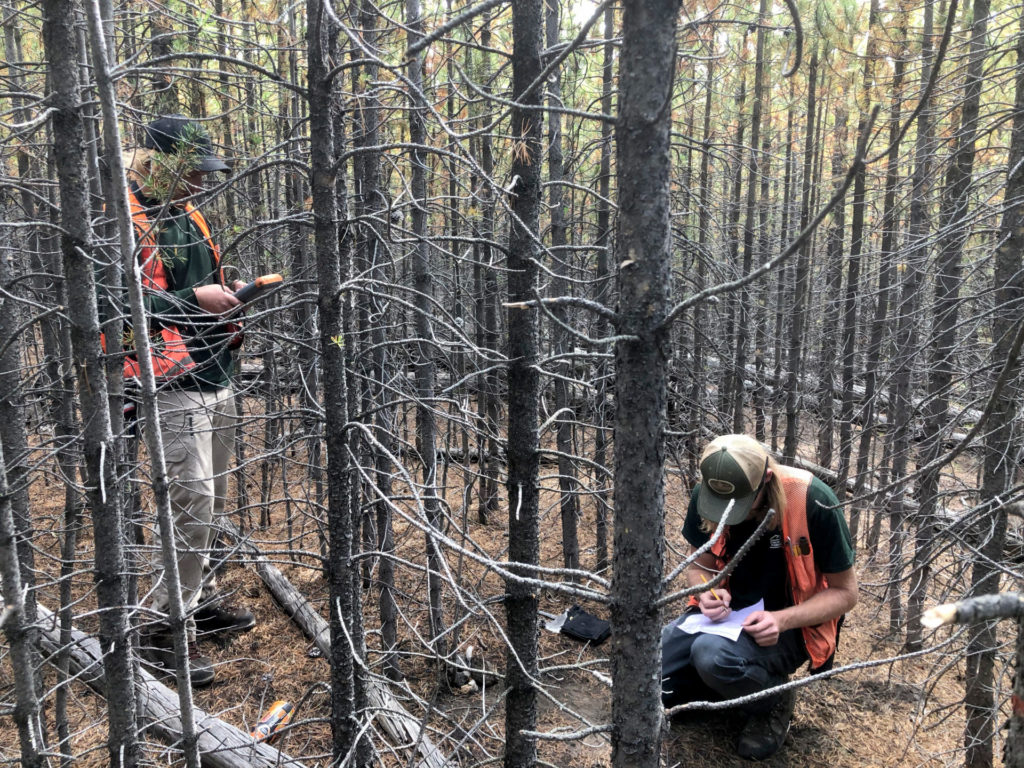
Kelsey Austin, a junior in the Department of Ecosystem Science and Sustainability, and Professor Wilfred Previant gather plot data in the park. Photo: Lucas Herman/Colorado State Forest Service
Some of us are fortunate to visit Yellowstone National Park in our lifetime, to experience its iconic geothermal features, scenery and wildlife. Far fewer of us are ever paid to explore the park – let alone gain research access to its off-trail backcountry settings.
In August, a group of Colorado State University staff and students did just that as part of a 24-member team of Colorado State Forest Service Forest Inventory and Analysis staff, volunteers, and U.S. Forest Service employees. They fanned out through the country’s oldest national park for two weeks, gathering data at more than 30 sites throughout the park.
The annual effort is part of the region’s Forest Inventory and Analysis program. The CSFS, a service and outreach agency of CSU’s Warner College of Natural Resources, leads the Colorado and Wyoming branch of this nationwide U.S. Forest Service research to monitor the health of forests on public and private lands. Each year, CSFS foresters and a handful of lucky volunteers visit Yellowstone to gather data to track forest conditions long into the future.
The Yellowstone backcountry represents the most remote study location in the lower 48 states, and accessing the more remote sites required unique transportation options, said Wilfred Previant, Colorado’s FIA program manager and Warner College professor. His crews’ 2019 efforts required going “by horse, by boat and by foot,” he said.
Some of the team crossed Yellowstone Lake by motorboat, others backpacked more than 60 miles, and some even traveled with outfitters by horseback, following ridgelines and valleys into undisturbed landscapes.
“Probably the best FIA memories come out of Yellowstone,” said Previant. “There you’re challenged unlike anything else.”
What is FIA?
For more than three decades, the FIA annual inventory has captured how forests change over time and provided scientific data on the extent, condition, volume, growth and health of the nation’s forests. Information on long-term trends helps researchers, policymakers, landowners and natural resource professionals better understand current forest conditions and significant changes across Colorado and the United States.
“One thing we’ve been looking at recently is regeneration,” Previant said. “Thousands of small trees should often replace fewer dead larger trees, but we’re not seeing that pulse in some stands and forest types. That’s a concern.”
FIA crews measure forest components on randomly selected two-and-a-half-acre plots. They record everything from soils and dead branches on the forest floor to understory vegetation, regeneration following wildfire and the health of standing trees. All Colorado data are compiled and stored at the Interior West FIA Office in Ogden, Utah, which also publishes notable findings.
Because the FIA program is so extensive, the USFS collaborates with state agencies and private contractors to gather information locally. Since the late 1990s, the agency has partnered with the CSFS to continuously update a comprehensive inventory and analysis of forest and rangeland conditions in Colorado and Wyoming. Colorado’s FIA program also does work in several other Western states.
In Colorado alone, the FIA program has established 4,500 permanent forest inventory plots; approximately 10 percent of these plots are examined annually. Because many of the plots are on private land, crew members work not just with government agencies, but also with tribal nations, homeowners, HOAs, ranchers and other private entities.
The state’s FIA crews collectively visit approximately 700 regional plots every year, including plots in urban forest settings, with fieldwork occurring from April through November. On average, each plot contains around 100 to 150 standing trees, in addition to downed trees, brush and other vegetation and material on the forest floor. The majority of the time crews are off-trail, and crew members can hike 300 or more miles annually and travel 10 to 16 weeks of the year.
“If you have a spouse, or pets, or a partner, or a social life, or even a house plant, well, you don’t have a summer,” Previant said, “…outside of having the greatest summer ever.”



Working in Yellowstone
Colorado’s FIA crews started working plots in Yellowstone National Park in 2014. Initially, only a few crews went, but staff numbers on the trip have grown, and hardy volunteers now join them. This year’s group also has strong ties to CSU. Between Previant and his crew members, 10 are university alumni. Four are also in the silviculture graduate program, and one is finishing his master’s degree – on post-mountain pine beetle recovery – through Warner College.
Being part of an FIA crew is a once-in-a-lifetime opportunity for volunteers – but they must come ready to work. Previant says a typical daypack is about 40 pounds, but for multi-night backcountry trips in Yellowstone, packs can weigh up to 90 pounds. Each crew hikes 50 to 100 miles over the two weeks, with 12-hour days common.
The added weight and distance are reasons horse packers and National Park Service boats are sometimes employed. Even crews going by foot run into obstacles, such as steep, off-trail slopes and dense stands of “jackstrawed” pines, where many dead trees have fallen and lodged into one another in haphazard fashion to complicate routes. In Yellowstone, these stands are a result of the 1988 wildfires.
The challenges at Yellowstone aren’t just related to transportation logistics. There’s the wildlife, including bison, and the potential for close encounters with grizzly bears. A major reason volunteers are needed for visiting Yellowstone’s backcountry plots is that the standard two-person crews aren’t large enough for adequate safety needs in grizzly bear country.
Crews try to mitigate the risk of bear encounters not just by having the larger group sizes, but also by going through bear training, which includes tips to make noise on the trail and carry bear spray. Nonetheless, some bruins are undeterred. Previant recalled one year when a large grizzly walked through an FIA spike camp at first light, as everyone was waking up. The crew members tried to scare it away to no avail. It was simply an indifferent bear, habituated to park visitors, and it ambled on its way.
Yellowstone’s bears may not appreciate FIA efforts, but program data provide valuable information about widespread changes to one of their key food sources. Whitebark pines are important in the diet of not only grizzlies, but also black bears, squirrels and birds like Clark’s nutcracker and blue grouse. Yet these pines are now considered endangered and have experienced widespread die-off because of factors including climate change, infection by white pine blister rust and mountain pine beetle infestations.
Experience well worth it
Challenges pop up every year in Yellowstone, and this year they included active wildfires that caused pre-planned routes and plots to be removed from the schedule. Minor injuries and illness also took a toll.
One of two CSU student volunteers, Kelsey Austin, fell ill halfway through the trip and had to return after a week, with her safety and the safety of the three-person crew working in the most remote area of the park being the top concern. Austin, an hourly employee of the CSFS Communications & Communities Division, is pursuing a bachelor’s degree in Ecosystem Science and Sustainability, and said despite her early departure, this experience was well worth it.
“It was so cool to be able to travel off-trail in a national park. We were able to see a lot of things that the regular person is not able to,” she said. “I was able to use information I’ve learned from my degree in a real-world situation, and would not hesitate to go again.”
For more information about the FIA program in Colorado, visit the CSFS FIA webpage.